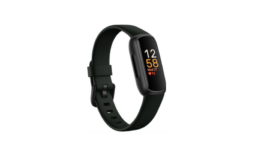Fitbit Flyer Wireless Headphones
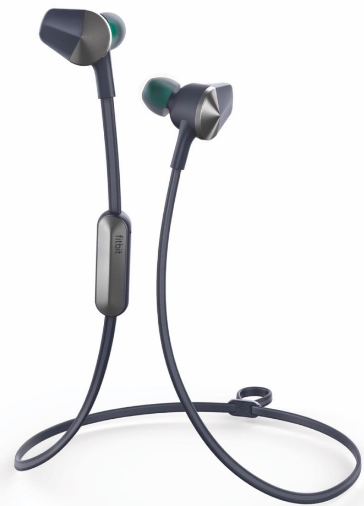
About Fitbit
Fitbit, Inc. is a manufacturer of wearable fitness devices with wireless capabilities. The company makes gadgets that track several personalized parameters, including sleep quality, steps taken, calories burnt, and more. Fitbit sells devices that help detect user movements by using accelerometers.
Getting Started – Fitbit
Welcome to Fitbit Flyer, the wireless headphones designed for workouts that pack crisp sound and powerful bass into a comfortable, sweat-proof, and secure design. Please take a moment to review our safety information at http://www.fitbit.com/safety.
What’s included
Your Flyer box includes:
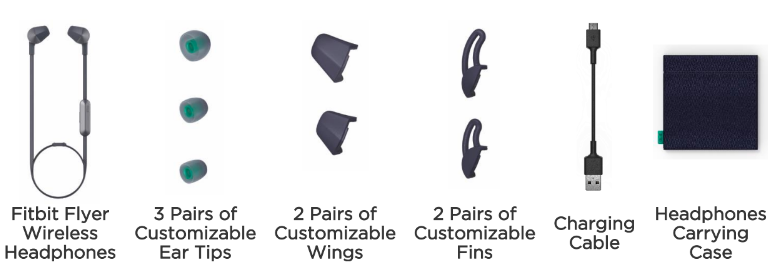
What’s in this document
We get you started by connecting Flyer with an audio device. After customizing the headphones to find the best fit, you’ll be ready to listen to audio and receive phone calls. Next, we explain how to adjust your settings, connect an additional device, and get the most out of Flyer. To find more information, tips, and troubleshooting, please browse our comprehensive articles at help.fitbit.com.
Setting up Fitbit Flyer
You must connect the Flyer to a Bluetooth®-enabled device. After connecting Flyer, you’ll be able to play audio and receive phone calls through your headphones.
Powering on
To power on the Flyer, press and hold the Power button until the LED lights up. If the Flyer does not turn on, it may need to be charged first. For instructions, see the Charging Flyer.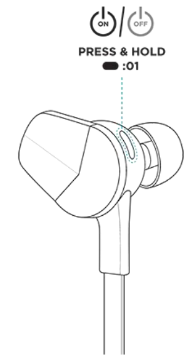
Connecting to devices
To pair Flyer to a device, you must put the headphones in pairing mode, indicated by a pulsing blue light.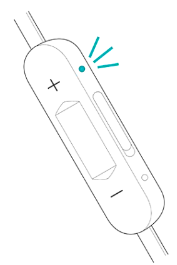
The first time you turn on Flyer, it will automatically be in pairing mode, and you can skip to step 2.
To pair Flyer to a new device:
- Press and hold the Power button for 4 seconds when turning on the Flyer, and wait until the LED pulses blue. If you release the Power button before the Flyer is in pairing mode, the Flyer turns on, but won’t pair to your device. If the Flyer doesn’t enter pairing mode, turn it off by holding the power button for 1 second, and try this step again.
- Open the Bluetooth menu on your device and select Flyer. You’ll hear an audio notification through the headphones letting you know Flyer and your device are paired.
When you pair Flyer to a new device, it is stored in Flyer’s memory. The flyer automatically attempts to connect to this device if it’s near the headphones when you turn them on. Flyer can store up to 8 Bluetooth-enabled devices, such as phones, tablets, and smartwatches.
If Flyer already has 8 devices in its memory and you pair a new device, it forgets the first device you paired. For more information about connecting Flyer to your devices, as well as troubleshooting tips, see help.fitbit.com.
Connecting to Fitbit Ionic
If you own a Fitbit Ionic watch, pair Flyer to listen to audio such as music, audiobooks, and podcasts. To pair Flyer, press and hold the Power button for 4 seconds when turning on the headphones, and wait until the LED pulses blue, which indicates Flyer is in pairing mode.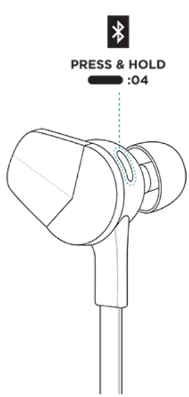
Changing the language
Flyer provides voice prompts for various notifications such as powering on and off, the current battery level, and how many devices the headphones are currently connected to. Flyer defaults to English; to change the language of these prompts, press the Power button and the Select button at the same time. Press the same 2 buttons again to switch to the next language.
Language selection is only available while your audio is paused and you are not on a phone call. The supported languages, in order, are:
- English
- French
- Italian
- German
- Spanish
- Chinese
- Korean
- Japanese
- No language (tones only)
Customizing your fit
The flyer comes with ear tips, wings, and fins. Attach the ear tips and either wings or fins before inserting the headphones into your ears to ensure a secure, comfortable fit.
Choosing ear tips
For optimal comfort and sound quality, you should select an ear tip that fits snugly in your ear canal. Flyer comes with 3 sizes (small, medium, and large) of ear tips; we recommend trying all 3 options to see which size works best for you. Choose the ear tip that seals the headphones with your ear canal to reduce outside noise and provide the best overall sound quality.
NOTE: You may want to choose a different-sized ear tip for your right and left ears.
To attach an ear tip, hold the earbud in one hand and the ear tip in the other hand. Press the ear tip fully onto the stem of the earbud until it fits snugly against it. To remove an ear tip, pinch it between your fingers and pull it off.
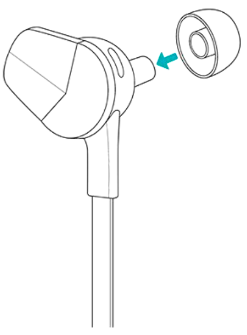
Choosing wings or fins
Flyer comes with 2 pairs of wings and 2 pairs of fins in small and large sizes. We recommend trying both sets of wings and fins to determine which provides the most comfortable and secure fit. Both wings and fins should tuck into the fold of your ear to keep the headphones in place.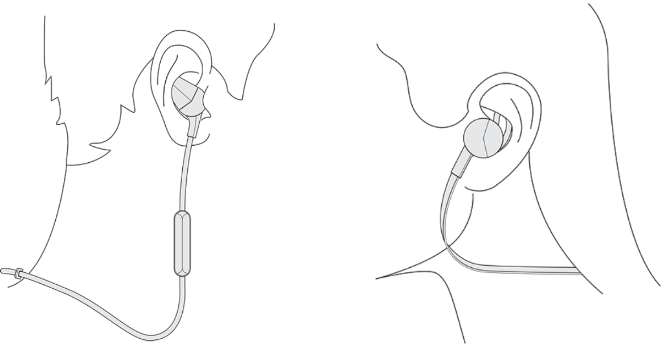
To attach a wing or fin:
- Slide the bottom edge of the wing or fin into the rounded slot of the earbud.
- Press down on the top of the wing or fin to insert it under the metal cap. It snaps into place when inserted correctly.

To remove a wing or fin, pinch the base of it between your fingers and pull away from the earbud to slide it out of the rounded slot.
Wearing your headphones
After you select the correct attachments, we recommend wearing a Flyer behind your neck with the controls on the right side. Tighten the sliding cable fastener to keep the headphones secure.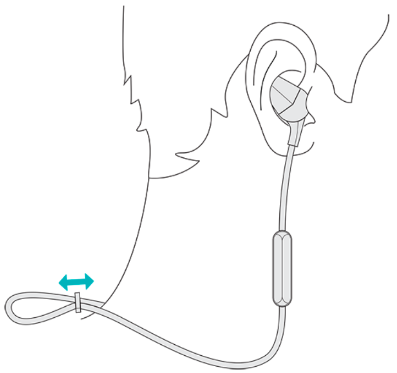
For more information on finding the best fit and wearing a Flyer, see help.fitbit.com.
Using the controls
The flyer has 3 buttons, located on the control box. Use these buttons to control your audio and phone calls.
Volume
Use the Up and Down buttons to control the volume of audio and phone calls, as shown in the table below.
Microphones
If you connect Flyer to a phone with a voice assistant such as Siri, Google Assistant, or Cortana, when your phone is nearby you can access the voice assistant with Flyer’s microphones. Access to a voice assistant is not available while you’re on a phone call. For instructions on accessing your phone’s voice assistant, see the table below.
Once you turn on a voice assistant, the microphone in Flyer picks up your voice, allowing you to use it as if you were speaking directly into your phone. For more information about accessing a voice assistant with Flyer, see help.fitbit.com.
Power boost
Use a power boost to enhance the sound quality of your music. To turn this setting on or off, briefly press the Up and Down buttons at the same time.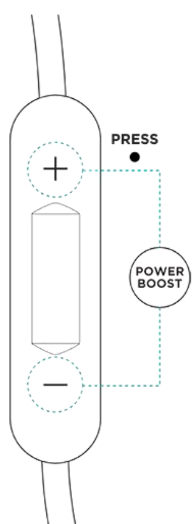
You’ll hear an audio notification telling you whether you turned the power boost on or off. Flyer uses this power boost setting until you change it again. Turning the power boost off helps conserve battery power. For more information about power boost, see help.fitbit.com.
Audio playback
To listen to audio, press play on the device Flyer is connected to. After the audio starts, use the Flyer to control it, as shown in the table below.
Phone calls
If the Flyer is connected to a phone, use the Flyer to answer, dismiss, or switch between calls. If audio is playing on your phone when a call comes in, the audio is automatically paused so you can answer your call. For instructions on how to control phone calls from your Flyer, see the table below.
Battery life and charging
Checking your current battery level
When you turn Flyer on or off, you’ll see the battery-level indicator light and hear an audio notification.
While the Flyer is on, check the current battery level at any time by briefly pressing the Power button.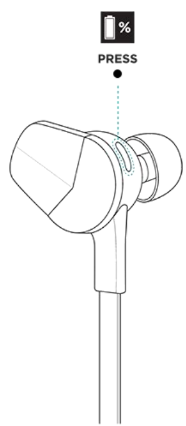
On many devices, the Flyer’s battery level is shown on the connected device. If Flyer is connected to Ionic, you can check the battery level on the watch’s shortcut screen (swipe right from the clock screen). When the battery level is Low or Very Low, the LED changes to red, and a voice prompt notifies you that the battery is low. For information on what the color of the LED represents, see the table below.
Charging Flyer
To charge the Flyer, plug the Micro-USB 2.0 charging cable into the Flyer’s charging port, located underneath the cover, and then plug the charging cable into the USB port on your computer or a UL-certified USB wall charger.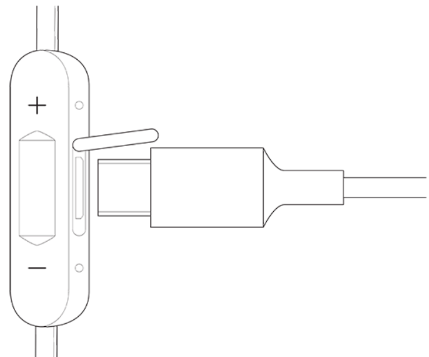
When the Flyer is charging, the LED changes color depending on the current charge level. Your headphones are fully charged when the LED is white. Charging fully may take up to 2 hours. For information on what the color of the LED represents while Flyer is charging, see the table below.
Wear and care
A flyer may require occasional cleaning. For instructions and more information, see https://www.fitbit.com/productcare.
Fitbit Flyer General Info & Specifications
- Materials
Flyer is made of a combination of silicone, polycarbonate, polyurethanes, elastomers, and aluminum. These materials allow the headphones to be flexible, durable, and lightweight. - Wireless technology
The flyer contains a Bluetooth 4.2 transceiver. - Battery
The flyer contains a rechargeable lithium-ion battery.
Learn more
Troubleshooting and assistance for Flyer may be found at help.fitbit.com.
Return policy and warranty
Warranty information and the Fitbit.com Store Return Policy may be found at fitbit.com/returns.
FCC STATEMENT
This device complies with Part 15 of the FCC Rules. Operation is subject to the following two conditions:
- This device may not cause harmful interference and
- This device must accept any interference received, including interference that may cause undesired operation.
FCC Warning
Changes or modifications not approved by Fitbit, Inc. could void the user’s authority to operate the equipment.
Note: This equipment has been tested and found to comply with the limits for a Class B digital device, under part 15 of the FCC Rules. These limits are designed to provide reasonable protection against harmful interference in a residential installation. This equipment generates, uses, and can radiate radio frequency energy and, if not installed and used by the instructions, may cause harmful interference to radio communications.
However, there is no guarantee that interference will not occur in a particular installation. If this equipment does cause harmful interference to radio or television reception, which can be determined by turning the equipment off and on, the user is encouraged to try to correct the interference by one or more of the following measures:
- Reorient or relocate the receiving antenna
- Increase the separation between the equipment and the receiver
- Connect the equipment to an outlet on a circuit different from that to which the receiver is connected.
- Consult the dealer or an experienced radio/TV technician for help.
Simplified EU Declaration of Conformity
Hereby, Fitbit, Inc. declares that the radio equipment type Model FB205 complies with Directive 2014/53/EU. The full text of the EU Declaration of Conformity is available at the following internet address: http://www.fitbit.com/safety.
©2017 Fitbit, Inc. All rights reserved. Fitbit and the Fitbit logo are trademarks or registered trademarks of Fitbit in the US and other countries. A more complete list of Fitbit trademarks can be found at http://www.fitbit.com/legal/trademark-list. Third-party trademarks mentioned are the property of their respective owners.
FAQs About Fitbit Flyer Wireless Headphones
Does Fitbit produce headphones?
Fitbit Flyer Wireless Headphones, Nightfall Blue: Electronics on Amazon.com.
Is Fitbit compatible with phones?
Press the green phone symbol on your wristwatch whenever someone calls you. Keep in mind that the Fitbit app must be open on your phone and operating in the background. To communicate with the other person, speak into your watch. Their voice comes over your watch’s speaker.
Does Fitbit make use of Bluetooth?
To add your activity before the Fitbit Challenge finishes, you can manually sync your Fitbit with your smartphone. This is something you might do to meet a Fitbit Challenge deadline. This is how it operates: Activate the Fitbit tracker and confirm that your phone is set to Bluetooth.
Does Fitbit make use of WiFi or Bluetooth?
Fitbit Aria Air watches, and trackers all sync with smartphones and tablets via Bluetooth Low Energy (BLE) technology. Fitbit Aria and Fitbit Aria 2 connect to your network directly via Wi-Fi. Check fitbit.com/devices to see if your device can sync with the Fitbit app.
What kind of technology does Fitbit use?
A 3-axis accelerometer is used by Fitbit to count steps taken as well as a few other metrics including distance traveled, calories burned, and floors climbed. An electromechanical instrument used to measure acceleration forces is called an accelerometer.
Is WiFi used by Versa 2?
Versa 2 features WiFi for faster, more dependable OS upgrades as well as for quicker downloads of playlists and apps from the Fitbit App Gallery. Open, WEP, WPA personal, and WPA2 personal Wi-Fi networks can all be connected to by Versa 2.
To what extent is Fitbit useful?
According to research, Fitbit users who log 10,000 or more steps a day are much less likely to acquire sleep apnea, obesity, depression, diabetes, and high blood pressure, among other chronic illnesses.
Is Fitbit functional without internet access?
No, you can see your stats on the Fitbit app and sync your device using Bluetooth on any Fitbit. Charge HR is the same. The internet is only required if you wish to use the computer dashboard.
Does my Fitbit have water resistance?
The majority of Fitbit devices can withstand 50 meters of water. They are made to withstand even the most intense exercises and are swimproof. Please refer to the table below and our user manuals for specific information about the splash and swimproofness of your equipment.
Are Fitbits GPS-enabled?
Your tracker maps your journey using the GPS sensors on your phone if you carry it with you. Your tracker uses built-in GPS if it is close to you when you begin the exercise but not moving.
For More Manuals by Fitbit, Visit Latest Manuals
- JVC HAFX7B Gumy in Ear Earbud Headphones Manual
- Soundcore Life P3i Hybrid Earbuds User Manual
- MEE audio Pebbles True Wireless Earbuds User Manual
- SoundCore Space NC A3021 Wireless HeadPhone User Guide
- Acoustics Research AWS5 Wireless Indoor-Outdoor Speaker Installation Manual
 |
Fitbit Flyer Wireless HeadphonesUser Manual [pdf] |




